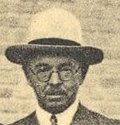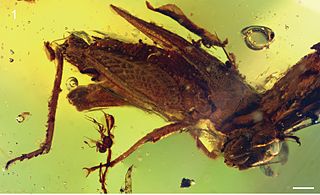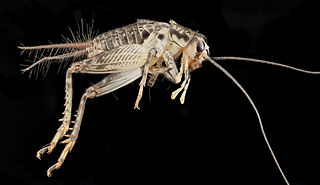Related Research Articles

Orthoptera is an order of insects that comprises the grasshoppers, locusts, and crickets, including closely related insects, such as the bush crickets or katydids and weta. The order is subdivided into two suborders: Caelifera – grasshoppers, locusts, and close relatives; and Ensifera – crickets and close relatives.

Locusts are various species of short-horned grasshoppers in the family Acrididae that have a swarming phase. These insects are usually solitary, but under certain circumstances they become more abundant and change their behaviour and habits, becoming gregarious. No taxonomic distinction is made between locust and grasshopper species; the basis for the definition is whether a species forms swarms under intermittently suitable conditions; this has evolved independently in multiple lineages, comprising at least 18 genera in 5 different subfamilies.

The Rocky Mountain locust is an extinct species of grasshopper that ranged through the western half of the United States and some western portions of Canada with large numbers seen until the end of the 19th century. Sightings often placed their swarms in numbers far larger than any other locust species, with one famous sighting in 1875 estimated at 198,000 square miles (510,000 km2) in size, weighing 27.5 million tons and consisting of some 12.5 trillion insects, the greatest concentration of animals ever speculatively guessed, according to Guinness World Records.

Grasshoppers are a group of insects belonging to the suborder Caelifera. They are among what is possibly the most ancient living group of chewing herbivorous insects, dating back to the early Triassic around 250 million years ago.

Ensifera is a suborder of insects that includes the various types of crickets and their allies including: true crickets, camel crickets, bush crickets or katydids, grigs, weta and Cooloola monsters. This and the suborder Caelifera make up the order Orthoptera. Ensifera is believed to be a more ancient group than Caelifera, with its origins in the Carboniferous period, the split having occurred at the end of the Permian period. Unlike the Caelifera, the Ensifera contain numerous members that are partially carnivorous, feeding on other insects, as well as plants.

The Caelifera are a suborder of orthopteran insects. They include the grasshoppers and grasshopper-like insects, as well as other superfamilies classified with them: the ground-hoppers (Tetrigoidea) and pygmy mole crickets (Tridactyloidea). The latter should not be confused with the mole crickets (Gryllotalpidae), which belong to the other Orthopteran sub-order Ensifera.

Tetrigidae is an ancient family in the order Orthoptera, which also includes similar families such as crickets, grasshoppers, and their allies. Species within the Tetrigidae are variously called groundhoppers, pygmy grasshoppers, pygmy devils or "grouse locusts".
Orthopteroids are insects which historically would have been included in the order Orthoptera and now may be placed in the Polyneoptera. When Carl Linnaeus started applying binomial names to animals in the 10th edition of his Systema Naturae in 1758, there were few animals included in the scheme, and consequently few groups. As more and more new species were discovered and differences recognised, the original groups proposed by Linnaeus were split up.

Sir Boris Petrovitch Uvarov was a Russian-British entomologist best known for his work on the biology and ecology of locusts. He has been called the father of acridology.

Pyrgomorphidae is a family of grasshoppers in the order Orthoptera; it is the only family in the superfamily Pyrgomorphoidea. Pyrgomorphidae is found worldwide in tropical and warm temperate regions, but the vast majority of the family's approximately 500 species are from Africa, Asia and Australia. Their name is probably derived from pyrgos meaning "tower": a reference to the form (morph) of the head in the type genus Pyrgomorpha and other genera.

Aularches miliaris is a grasshopper species of the monotypic genus Aularches, belonging to the family Pyrgomorphidae. A native of South and Southeast Asia, the bright warning colours of this fairly large grasshopper keep away predators and their defense when disturbed includes the ejection of a toxic foam.

Electrotettix is an extinct genus of pygmy locust found in amber collected in the Dominican Republic. Represented by a single species, Electrotettix attenboroughi, which lived 18-20 million years ago, it fed primarily on moss, fungi, and algae. The genus name is derived from electrum, Latin for "amber", and Greek tettix, meaning "grasshopper". The species was named after Sir David Attenborough. The female measures 8 millimeters in length: the male is unknown. The species is distinguished from modern members of the Cladonotinae subfamily by the fact that it retains vestigial wings, a feature lost somewhere between the ancient specimens and more modern species. E. attenboroughi was identified from a collection of amber at the Illinois Natural History Survey, which had been stored in a cabinet under a sink since it was collected in the 1950s by entomologist Milton Sanderson.

George Basil Popov MBE, was a Russian-British entomologist born in Iran, his father having been employed there by the Imperial Bank of Persia. Popov became an authority on the Desert locust.

Anacridium moestum, the camouflaged tree locust, is a species of grasshopper belonging to the family Acrididae, that is native to Africa south of the equator. It is similar in appearance to the Southern African desert locust, Schistocerca gregaria flavicentris. It is likewise brownish, large and slender, but mostly arboreal in its habits.

Acrididea including the Acridomorpha is an infraorder of insects that describe the grasshoppers and ground-hoppers. It contains a large majority of species in the suborder Caelifera and the taxon Acridomorpha may also be used, which excludes the Tetrigoidea. Both names are derived from older texts, such as Imms, which placed the "short-horned grasshoppers" and locusts at the family level (Acrididae). The study of grasshopper species is called acridology.

Capnobotes fuliginosus is a species of katydid known as the sooty longwing. It is found in the western United States and Mexico. It is omnivorous and it is the prey of the wasp Palmodes praestans.

Velarifictorus micado, the Japanese burrowing cricket, is a cricket in the subfamily Gryllinae. It is found in southern Asia, along with an introduced population in the United States. It was first reported in the US in 1959, likely as overwintering eggs in the soil of imported plants, and has since spread all throughout the eastern half of the country.

Neoconocephalus retusus, the round-tipped conehead, is a species of katydid or bush cricket in the family Tettigoniidae. It is found in the eastern United States and southern Canada.

Orchelimum nigripes, known generally as the black-legged meadow katydid or red-legged meadow grasshopper, is a species of meadow katydid in the family Tettigoniidae. It is found in North America.
Nadejda "Nadia" Waloff FRES was a Russian-born English entomologist. She worked on the biology of locusts, flight and dispersal of the Hemiptera, and taught at Imperial College, Silwood Park campus.